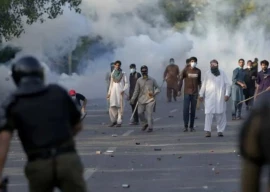
According to a report by the Uks Research Centre and DANDIA (the Danish international development agency), the growth of women in media is mostly horizontal and not vertical - which means that they are growing in number but not reaching new professional heights. The report, titled ‘Who’s telling our stories? A situational analysis of women in media in Pakistan’, documents a two-year project and was launched on Wednesday.

Media monitoring and content analysis was part of the Uks project, in which qualitative and quantitative analysis of selected print and electronic media were conducted for their gender sensitivity for one week in March 2012 (left). A basic survey was conducted in media houses from across the country to gain an insight into the ratio of male vs female practitioners in the media sector in Islamabad, Lahore, Multan, Quetta, Hyderabad, and Peshawar (right).
The report looks into how the media offices are viewed as an unsafe working environment by parents, also one of the reasons for the low number of women working in the industry as compared to the number of female graduates of media programmes.
Language barriers
According to the report, gender inequality is prevalent more in Urdu print media as compared to the English newspapers. Veteran journalist, Zubeida Mustafa, however, pointed out that it wasn’t only the language but the attitudes that create a working environment. “Language doesn’t make anyone a better journalist,” she said. “The ground reality is that for equality in media, changes in thinking and attitudes at the top level are required.”
Mazhar Abbas, the director current affairs at Express News, was of the view that the newsroom language also created problems in the working space. “The number of women reporters in the print media is not that high also because of the newsroom language. In many channels, female news anchors have separate rooms because of this reason,” said Abbas. Author Bina Shah, however, did not agree and said, “The trend to shelter women in separate room is dangerous - we need to realise that women are strong and a little crassness won’t make them fall apart.”
Changing perceptions
“Compared to earlier years, the number of female workers in the media has increased but at the same time, the dropout rate after graduation has been higher. In our society, people view educational qualifications as a way to get better marriage proposals and that perception has to be changed,” said Prof. Dr Tauseef Ahmed of the Federal Urdu University of Arts, Science and Technology.

“To attract and retain female journalists, we need to provide them with facilities and flexible working hours,” said Bina Shah. “Everyone needs to know that there are no concrete steps to scoring a good husband.”
Sheema Kirmani, renowned classical dancer who was also present at the launch, said, “If women have no place in the society, how are they going to be empowered. The concept of morality is another hindrance as women in the media are often considered of ‘loose character’ in the society.”
In Shah’s opinion, people should not get intimidated by such cultural and moral values. “The women in media play a major role by representing their gender.”

Perception of women by their own gender was brought up by Sadia Mehmood, assistant professor at Karachi University. “Women don’t take themselves seriously so their teachers don’t take them seriously as well. We need to change the whole cultural mindset for real difference.”
Shahida Qazi, a pioneer in journalism proudly said, “I am the first female gold medalist in journalism studies, I joined Dawn as the first female reporter, and later, joined PTV as the first female news editor. There are multiple opportunities for women to work in media - you just have to seize the right one.”
Published in The Express Tribune, July 12th, 2013.
COMMENTS (1)
Comments are moderated and generally will be posted if they are on-topic and not abusive.
For more information, please see our Comments FAQ























Female journalists are being hired by not given appropriate environment for their professional growths , that's why some females give up this profession,lack of trainning and no membership at press clubs make them lost ...........